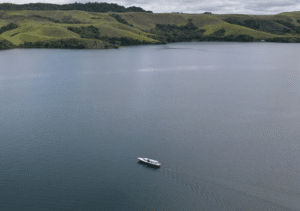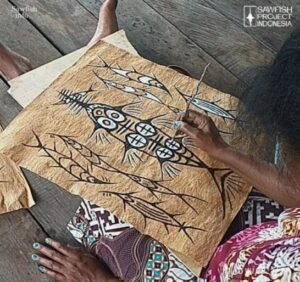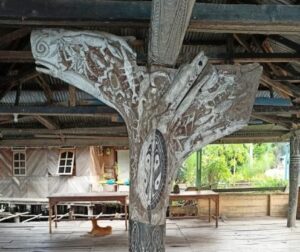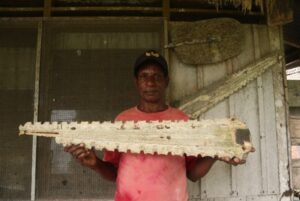What do you picture when you hear the name “sawfish”?
Is it a big fish with a scary saw snout? Or a kind of shark that is dangerous and likes to attack humans? If so, it means you are still confused about this beautiful species.

Illustration by Mark Garrison, Hakai Magazine
You may be surprised to hear that sawfish are not sharks. They are a group of rays along with giant guitarfish and wedgefish. And though we can easily recognize sawfish by their saw, the presence of the saw does not mean it is a dangerous animal. In fact, sawfish are docile animals and do not like to attack humans except when they feel threatened. But despite their gentle nature, the sawfish has been a target of hunting due to the high value of their fins, meat, and their saw — also called a rostrum — and are considered one of the most endangered fish in the world.
Sawfish populations are distributed in several regions, and 4 out of 5 sawfish species can be found in Indonesian waters. Unfortunately, there is little recorded data despite the sawfish being protected under Indonesian law since 1999. To change this, Sawfish Indonesia is conducting surveys to track the existence of sawfish in the eastern part of Indonesia, starting from the Lake Sentani, Merauke, to Asmat.
The Lake
Sawfish Indonesia started by searching for traces of sawfish in Lake Sentani, Papua. According to several scientific papers, they were last observed here in 1974. Environmental-DNA (e-DNA) and local ecological knowledge were used to learn more about the sawfish’s local extinction in the lake.

View of Lake Sentani. Photo credit: Oceanogen
As the first step, we conducted an environmental DNA analysis in Lake Sentani by taking water samples at several points and analyzing them in the laboratory to detect the sawfish’s presence. As expected, we found no sawfish from this analysis. Upon further research with the local communities, we also discovered some fascinating cultural evidence.

Bark painting with sawfish pattern in Asei village. Photo: Sawfish Indonesia
There are two slightly different local names for sawfish, which varied depending on which side of the lake people lived on. Some of the older villagers, most of which were over 50 years of age, claimed they had even caught sawfish around the lake, while those from younger generations only heard stories of them. The timeline we can construct is that the last sawfish sighting was in the 1970s to 1980s, when gillnets were introduced to the local communities. Today, material traces of sawfish can be found in the form of carvings, preserved “saws” from largetooth sawfish, and bark paintings by the people of Asei village called “Khombow”

Sawfish carving seen on the main pole of Dondai traditional house. Photo: Sawfish Indonesia
The Sea
After finishing at Lake Sentani, we headed to the Merauke coast as our next research point. Instead of seeking evidence of extinction as we did in Sentani, we searched for evidence of existing sawfish, most of which were caught in the Arafura Sea. We conducted interviews in several coastal areas of Merauke, starting from Lampu Satu Beach, Naukenjerai, to Wanam, passing endless mangrove trees and water clouded by mud and sand. During the research, we examined over 37 rostrums representing all four species (narrow, green, dwarf, and largetooth sawfish), and ten of them were caught in the last ten years.

Lampu Satu beach. Photo: Sawfish Indonesia

Head of the village from Sawa Erma holding an old sawfish rostrum. Photo: Sawfish Indonesia
The Swamps of Asmat
Of the several areas we have visited, Asmat is one of the most challenging areas. It can only be crossed by water transportation through the river, because 80% of Asmat’s geography consists of swamps and wetlands. Besides that, our departure schedule from one area to another depends on the weather. Rain and even storms are loyal companions of our journey.

Sawfish survey with local people. Photo: Sawfish Indonesia
Fortunately, with the support from the Save Our Seas Foundation, we managed to finish our research journey in Asmat waters — its rivers, estuaries, and coastal areas. Like the merger of Lakes Sentani and Merauke, we got evidence of sawfish in Asmat through rostrum collected decades ago until the most recent catch in 2018. We also found carvings of sawfish, establishing their presence in the local culture of the Asmat tribe.

Request permission and give research explanations to the local community. Photo: Sawfish Indonesia
We were very touched when the fishermen voluntarily recorded and reported the sawfish findings. In addition, the openness of the local community in providing the information makes it easier for us to carry out expeditions. The government has also allowed us to present the results of our research so that they can be used as a reference for policymaking and future conservation efforts. The enthusiasm and involvement of local communities, fishermen, and the government make us believe there is great hope for sawfish survival.


